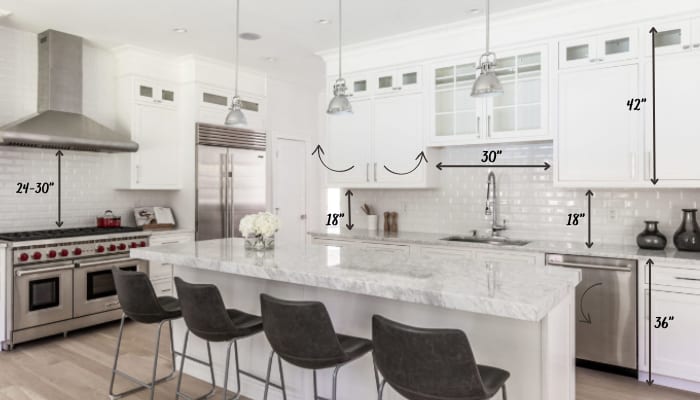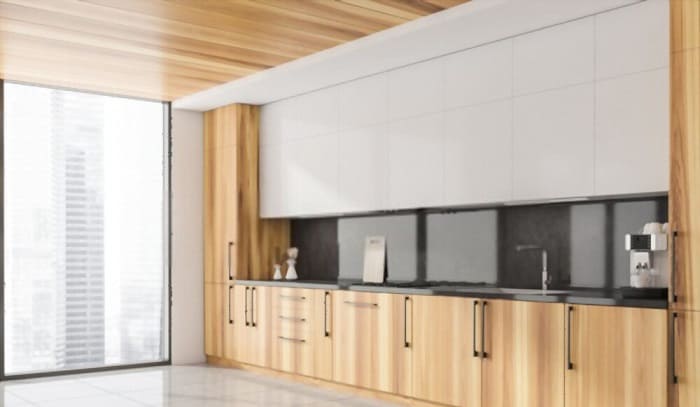Understanding the Relationship

The transition from countertop to upper cabinets is a critical design element in any kitchen. It not only affects the visual flow of the space but also influences the functionality and overall aesthetic. This section will explore the design principles behind this transition, focusing on how countertop materials and cabinet styles interact to create a cohesive and visually appealing kitchen.
Countertop Material and Cabinet Style Relationships
The choice of countertop material significantly impacts the selection of upper cabinet styles. Different materials possess distinct characteristics that influence the overall design aesthetic. For instance, a sleek and modern quartz countertop might pair well with minimalist cabinets featuring clean lines and flat panels. In contrast, a rustic granite countertop with its natural veining and texture could complement traditional cabinets with ornate details and crown molding.
- Granite: The natural veining and unique patterns of granite lend themselves to traditional and farmhouse-style kitchens. They pair well with cabinets featuring raised panel doors, crown molding, and decorative hardware.
- Quartz: Quartz countertops offer a sleek and modern look, making them ideal for contemporary kitchens. They complement minimalist cabinets with flat panel doors, simple hardware, and clean lines.
- Laminate: Laminate countertops are highly versatile and can be found in various styles and colors. They can complement both traditional and contemporary cabinets, depending on the chosen design.
- Wood: Wood countertops bring warmth and natural beauty to any kitchen. They pair well with cabinets featuring traditional or rustic styles, such as shaker doors or beadboard panels.
Color and Finish Integration
Achieving a cohesive look involves harmonizing countertop and cabinet colors and finishes. Contrasting colors can create a bold and dramatic statement, while complementary shades offer a more subtle and sophisticated aesthetic.
- Contrasting Colors: A dark countertop like black granite can be paired with light-colored cabinets, creating a striking visual contrast. This approach adds visual interest and defines the space.
- Complementary Colors: A warm brown countertop might pair well with cabinets in a soft cream or beige, creating a harmonious and cohesive look. This approach promotes a sense of balance and tranquility.
- Matching Finishes: Matching the finishes of the countertop and cabinets, such as a matte countertop with matte cabinet doors, creates a seamless and cohesive look.
“The countertop and cabinet transition is a key element in kitchen design, impacting both functionality and aesthetics. By carefully considering the relationships between materials, styles, and finishes, you can create a space that is both visually appealing and practical.”
Design Considerations

The relationship between countertop height and upper cabinet placement is crucial in kitchen design. It directly influences the functionality, aesthetics, and overall usability of the space. Understanding the impact of ceiling height, cabinet door styles, and the strategic layout of these elements is essential for creating a kitchen that is both efficient and visually appealing.
Ceiling Height and Countertop-to-Upper Cabinet Design
The height of the ceiling plays a significant role in determining the ideal countertop-to-upper cabinet configuration. In kitchens with high ceilings, there is more flexibility in choosing the placement of upper cabinets. For instance, taller cabinets can be installed, maximizing storage space and creating a sense of grandeur. However, in kitchens with low ceilings, the upper cabinets need to be placed lower to avoid a cramped feeling and ensure adequate headroom. This might necessitate the use of shorter cabinets or a combination of standard and smaller cabinets to maintain a balanced visual appeal.
Advantages and Disadvantages of Different Cabinet Door Styles
Cabinet door styles contribute to the overall aesthetic of the kitchen and can impact the functionality of the space.
- Shaker Doors: Shaker doors, characterized by their simple, recessed panel design, offer a timeless and versatile look that complements various kitchen styles. Their flat surface makes them easy to clean and maintain. However, their lack of intricate detailing might not be as visually striking as other styles.
- Raised Panel Doors: Raised panel doors feature a raised center panel that adds depth and dimension to the cabinet face. They offer a more traditional and elegant look compared to shaker doors. However, the raised panels can collect dust and require more cleaning.
- Flat Panel Doors: Flat panel doors are characterized by their sleek, minimalist design. They create a modern and streamlined aesthetic. Their smooth surface is easy to clean and maintain, making them a practical choice. However, their lack of detailing might be considered too plain by some.
The choice of cabinet door style depends on personal preference and the overall design theme of the kitchen.
Kitchen Layout Optimization with Countertop-to-Upper Cabinet Configuration
Consider a kitchen layout where the countertop-to-upper cabinet configuration is designed to optimize workflow and storage.
- Island with Upper Cabinets: A central island with upper cabinets on one side can create a functional and visually appealing workspace. The upper cabinets provide ample storage for frequently used items, while the countertop offers a dedicated space for food preparation, dining, or casual seating. This configuration enhances workflow by keeping essential items within easy reach.
- Wall-Mounted Upper Cabinets with Varying Heights: Along a wall, a combination of standard and smaller upper cabinets can be strategically placed to accommodate different needs. Taller cabinets can be used for storing larger items, while smaller cabinets can be placed above the sink or stove for easy access to frequently used items. This configuration maximizes storage space while maintaining visual balance.
This layout promotes efficient movement between the sink, stove, and refrigerator, while maximizing storage and minimizing wasted space.
Practical Applications: Countertop To Upper Cabinets

The relationship between countertops and upper cabinets is not merely aesthetic; it significantly influences the functionality and usability of your kitchen. This section delves into practical applications that demonstrate how these elements work together to create a cohesive and efficient space.
Countertop Edge Profiles
The choice of countertop edge profile plays a crucial role in determining the overall look and functionality of your kitchen. Each profile has its own set of advantages and disadvantages, particularly when considering the transition between the countertop and upper cabinets.
- Edge Profile
- Pros
- Cons
| Edge Profile | Pros | Cons |
|---|---|---|
| Eased Edge | – Smooth, rounded profile. – Offers a comfortable and safe edge for everyday use. – Suitable for modern and contemporary kitchens. |
– Can be prone to chipping if not properly maintained. – Not as durable as other profiles. |
| Beveled Edge | – Adds a subtle visual interest to the countertop. – Creates a clean and modern look. – Relatively durable and resistant to chipping. |
– May be slightly less comfortable than an eased edge. – Can be more challenging to clean due to the angled surface. |
| Ogee Edge | – Adds a decorative element to the countertop. – Creates a traditional and elegant look. – Offers a smooth and rounded edge for comfortable use. |
– Can be more expensive than other profiles. – May not be suitable for all kitchen styles. |
| Bullnose Edge | – Creates a rounded and smooth edge. – Offers a comfortable and safe surface for everyday use. – Suitable for both traditional and contemporary kitchens. |
– Can be more expensive than a standard edge. – May not be as visually interesting as other profiles. |
Lighting Choices
Lighting plays a critical role in enhancing the visual appeal of the countertop-to-upper cabinet transition. Strategically placed lighting can highlight the countertop’s surface, create a sense of depth, and draw attention to the overall design.
- Under-cabinet Lighting: Provides task lighting for the countertop and workspace, while also creating a warm and inviting atmosphere.
- Pendant Lighting: Adds a stylish element and provides focused illumination over the countertop, highlighting its texture and color.
- Recessed Lighting: Creates a soft and diffused light that illuminates the entire kitchen space, including the countertop and upper cabinets.
- Accent Lighting: Highlights specific features, such as a backsplash or decorative elements, adding visual interest and depth to the transition.
Backsplash Installation, Countertop to upper cabinets
A backsplash serves as a protective barrier between the countertop and upper cabinets, while also adding a decorative element to the kitchen. It can complement the countertop and upper cabinets, creating a cohesive and visually appealing design.
- Preparation: Measure the area where the backsplash will be installed and determine the type of material you will use.
- Installation: Begin by applying a thin layer of mortar or adhesive to the wall. Install the backsplash tiles, ensuring they are level and aligned.
- Grouting: Once the adhesive has dried, apply grout to the spaces between the tiles, filling them completely.
- Sealing: After the grout has dried, seal the backsplash to protect it from stains and moisture.
Countertop to upper cabinets – From the sleek lines of your countertop to the airy heights of your upper cabinets, every inch of your home deserves a touch of personal style. And what better way to infuse your personality than with stunning women’s bedroom wall decor ?
Imagine the vibrant colors and textures that can transform your kitchen into a space that truly reflects you. Just like a well-designed wall, a beautifully organized countertop can be the foundation for a home that’s both functional and fabulous.
When designing your kitchen, the space between your countertop and upper cabinets can feel like a design dilemma. But don’t fret! This space can be a canvas for your creativity. Think about the overall aesthetic you want to achieve, like a calming and sophisticated vibe that complements light blue green bedroom walls.
This serene color scheme can inspire you to create a similar feel in your kitchen, where the space between your countertop and upper cabinets can be used to display your favorite pieces or create a focal point. So, let your imagination run wild and create a kitchen that reflects your personal style!